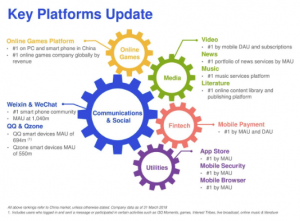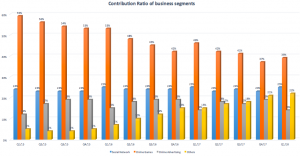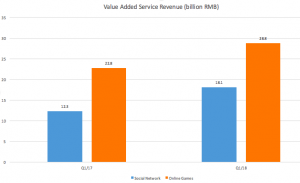- First quarter earnings beat analyst expectations
- Rebounded gaming business allayed investors’ concerns
- WeChat MAU achieved 1 billion milestone
- Investment spree cost RMB 21.1 b (US$ 3.3b) in Q1 FY18
Chinese internet conglomerate Tencent surged to a record high of beating Facebook in market value temporarily in January 2018, becoming the world’s fifth most valuable company at that time.
However, following which has seen share price slide amid rampant concerns with its aggressive spending hammering diminished margins.
The Shenzhen-headquartered company just released its better-than-expected quarterly results beating forecasts and bolstering investors’ confidence, as reflected by Tencent shares opening up 7% this Thursday morning.
Revenue grew at 48% year-on-year, with profits increasing by 60% from Q1 2017, according to the latest earnings results.
Tencent Business Model
As China’s leading provider of Internet value-added services, Tencent has multiple business areas, ranging from social network and communications, online games and advertising, media and entertainment, to technology investments.

According to a Wall Street Journal article, the social media and video games giant, Tencent has bought stakes in 277 startups since 2013. The company’s deal-making even surpassed archrival Alibaba Group in 2017, citing from a Bernstein Research.
Tencent has been investing in a wide assortment of startups ranging from AI, self-driving, brick-and-mortar stores to gaming companies in its fierce competition with archrival Alibaba on all fronts, especially in the new retail sector.
Tencent has fought its Battle of Waterloo with it eventually ceding the ground to JD through folding its failed ecommerce platforms to and taking stakes in JD.com. However, with the concept of new retail and its WeChat payment function becoming ubiquitous, Tencent apparently was planning a comeback by staging a costly fight, working alongside JD to buy their way into a slew of local retailers.
A closer look at the different business segments might offer a glimpse of the main revenue drivers at Tencent.

While Tencent has grown at amazing rates since inception, the three broad revenue segments namely social network, online games and online advertising have experienced fluctuations in their contributions to the firm’s revenue. Tencent has successfully diversified since 2015 as seen by a more even contribution spread among the key segments.
Broadly speaking, the main drivers of revenue are value added services, online advertising and an ‘other’ category. Internet services still remained the main driver of revenue, accounting for close to 64% of total revenue.
Gaming remains strong
Overall, value added service grew by approximately 34% over the past year and 17% from the last quarter. The two core drivers, namely social network and online games grew by 47% and 26% year-on-year respectively.

Exclusive video content offerings drove 85% year-on-year increase in video subscription revenues, with digital content subscription hitting 147 million this quarter, culminating in social network revenue growing by 47% over the past year.
Venturing into tactical tournament genre – with a pending licensed PUBG PC license, a multi-player online battle royale game, two in-house mobile titles enjoying break-out success and high quality platform strength, Tencent is set to reap the benefits in the explosive user growth in the online gaming area.
Despite the trend moving away from PC to smartphone gaming – a rather flat revenue growth with declining active PC user year-on-year, Tencent’s content updates and active marketing during the Lunar New Year period contributed to a 10% growth from the previous quarter.
Tencent is also capturing the smartphone gaming market, with a double-digit year-on-year growth in daily active users (DAU) for blockbuster title – ‘ Honour of Kings’. Stable paying ratio and strong average revenue per user growth, coupled with continued testing of new play mode and content can be expected going forward.
Online Advertising Quarterly Results
The company’s fluctuation of online advertising business could be due to seasonality.
Tencent also started experimenting with WeChat moment ads, think of ads juggled in Facebook feeds. Currently, Tencent WeChat moment ads grow at 2 ads per day as rapid traffic is building, with the expansion of advertiser base. While this segment only accounted for nearly 15% of total revenue, impressive video ads revenue growing at 64% over the past year might signal for greater future growth that can be expected.
Furthermore, huge potential for future growth is likely given Tencent’s current ad loans being only a fraction of industry benchmarks.
Conclusion
Massive profits growth driven by a rebound in the gaming sector – the biggest concern amongst investors prior to the earnings announcement – seemed to have turned the tides, stabilizing the growing earlier uncertainty.
However, the magnificent quarter profits might be hard to better or replicate – considering the ‘other’ segment accounting for close to 22% revenue this quarter could be due partly to a one-time investment gain of almost 7.6 billion yuan, according to Business Times.
It is also noteworthy to observe that cost of products sold has risen to a whopping 51% – with the largest growth in sales & marketing cost at 76%. Worryingly, net cash flow of Tencent is also negative this quarter.
Nonetheless, Tencent’s gaming business, continued innovation and wise investment decisions can be said to have successfully led to its success today. Rapidly intensifying competition requires unconventional methods employed and the race continues.
Editor: Ben Jiang
